Duncan Rhodes Two Thin Coats Paints Review
Since leaving Games Workshop, Duncan Rhodes has carved a formidable slice of the international hobbysphere out for himself. With legions of loyal fans and a knack for producing top-quality content, GW’s errant child has gone from strength to strength, first establishing his Painting Academy and associated YouTube channel. Gone are the days when his photo was worshipped in the hallowed halls of mid-2010s Games Workshop stores – instead, we now live in an Upside-Down where you can now buy Duncan’s own line of paints from your FLGS.
Please Note: This site uses affiliate links. Our Affiliate Partners are shown below
(Affiliate links will result in compensation to the site on qualifying purchases)
Click this link & buy your hobby stuff from Element Games for the UK & Europe to support FauxHammer.com – Use Code “FAUX2768” at the checkout for double reward points.




Our Affiliates / Hobby Stores
- UK: Element Games, The Outpost, Wayland Games, Mighty Lancer, Goblin Gaming, Forbidden Planet, Model Scenery Supplies, eBay, Amazon
- US/Canada: MTechCave, GameKastle, eBay (US), eBay (CA), Amazon
- Germany: Taschengelddieb
- Europe: eBay (DE), eBay (FR), eBay (ES), eBay (IT), Amazon
- Australia: eBay, Amazon
- Global: RedGrass Games, Warcolours
- 3D Printers: Phrozen 3D, Elegoo, Anycubic
FauxHammer – Latest Video on YouTube
Duncan Rhodes Two Thin Coats Paints Review – Summary
Duncan Rhodes’ Two Thin Coats Paints come out swinging. Following an enormously successful Kickstarter, Duncan’s team and the brainboxes at Trans Atlantis Games have created an excellent – albeit somewhat limited at this stage – range of paints that threaten to snatch away huge chunks of the hobby market from their competitors.
Duncan Rhodes Two Thin Coats Paints Review – Introduction
Within the international hobbysphere, we don’t really do celebrities.
“Stardom” and “miniature painting” aren’t two phrases you’d expect to see within touching distance of each other, and yet there is perhaps one person who can lay claim to such status. And that person is Duncan Rhodes.
For the totally new and completely unaware, Duncan Rhodes is the original (and now former) Games Workshop painting presenter. Duncan’s videos, which were posted to Warhammer’s YouTube, have been viewed millions of times by painters across the world and to this day remain amongst GW’s most popular tutorials on their channel.
Duncan’s basic but beautifully executed style made the forbidding word of miniature painting accessible to more people than ever before. Using only a handful of colours and a few brushes, Duncan would deftly create masterfully-painted miniatures with ease – and would impart his knowledge to you as he did so.
Duncan’s videos – where he’d sit off-centre against a black background, Mephiston Red water cup before him and dressed in an instantly-recognisable GW black polo – formed the framework into which all subsequent GW videos would try to fit. It’s a format they still use to this day, and one that very clearly works.
As a beginner painter, I watched Duncan’s videos with awe as complex concepts and more advanced techniques such as highlighting instantly began to make sense. What’s more, Duncan’s ethos resinated with me – as it did hundreds of thousands of others across the word : keep it simple…
…”and always apply two thin coats to your miniature.”
Duncan departed Games Workshop at the end of 2019, and the space he left has for the most part that gone unfilled. Whilst the combined (and oft meteoric) might of Chris Peach and Nick Bayton formed a formidable plug in the void-like space left by Duncan’s departure, both individuals have since moved on to other things – Nick the Battle Reports Team at Warhammer World, and Peachy following in Duncan’s footsteps and going independent with his new(ish) YoutTube channel The Painting Phase, which has proved to be very popular.
But Duncan’s departure from GW was not the end of his involvement in the miniatures hobby – far from it, in fact. Duncan, the Wayward Child, the One Who Got Away, has established his own painting academy where he continues to do his own God’s work imparting his encyclopaedic knowledge of all things hobby to his legions of fans for the low cost of £3.99 a month. And, yes, he still puts videos up on YouTube.
Much like the man himself, Duncan’s insistence that painters always thinned their paints and applied two thin coats wherever possible sparked a meme that refuses to go away. In fact, so persistent has the meme become that Duncan has released his own line of paints bearing the title “Two Thin Coats Paints”.
Given Duncan’s incredible legacy, you can be really sure we all sat up and started paying attention when it was announced he’d be bringing out his own line of paints. Beginning life as an unprecedentedly popular Kickstarter that raised in the region of $1,200,000 in September of 2021, Duncan’s paints have been hitting shelves and hobby desks across the road over the last few months.
As far as the global hobby community is concerned, Duncan is a man with a nigh-untouchable legacy, whose efforts, whose creativity, and whose genius has inspired thousands. To say high standard are, therefore, expected would likely be an understatement. So, how do Duncan’s Two Thin Coats Paints (which were created in partnership with trans Atlantis Games and Duncan’s Painting Academy heavy Roger Yates) measure up?
Duncan Rhodes Two Thin Coats Paints Review – Design
First off, we need to say a massive thanks to our friends at Trans Atlantis Games for sending us the entire current Two Thin Coats paint range for this review. You guys rock.
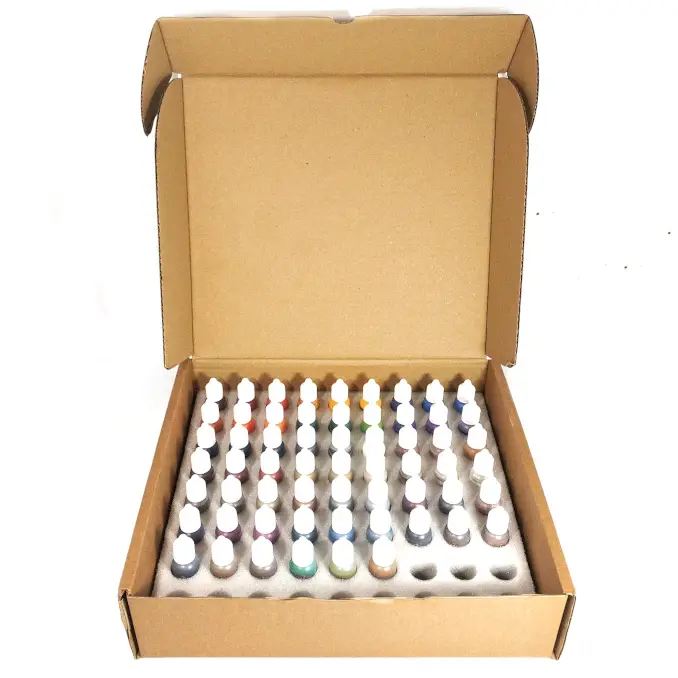
There are currently 60 paints in the range which have been designed to colour as much of a spread of the colour spectrum as possible.

Within those 60 paints are 6 matt-finish washes and 6 metallic paints – 3 golds and 3 silvers (though one of the golds is a colour match to Citadel’s Balthazar Gold which is quite bronzy in colour). The other 48 colours are a mix of primary and secondary colours, all of which have been designed to be used as base layers and highlights with each other in the form of “triads” of ascending colour.

The paints themselves come in dropper bottles (which will be a relief to a lot of painters). Said dropper bottles also all include agitators, which helps ensure the paints mix well when you shake them before use.
Yes, your eyes are not deceiving you: dropper bottles.
Dropper bottles are great. They allow you more control over the amount of paint you add to a palette and thus reduce waste. That these dropped bottles also have agitators in them means that it’ll be really easy to ensure your paints are not separated by giving each bottle a quick shake before use.
However, the Two Thin Coats bottles are not flawless.

A lot of the dropper bottles do dribble. The above, which is of the Marine Blue paint, was selected at random from the box and opened after I noticed quite a few of the paints were leaking on their first use.
This is a bit of a irk. As mentioned above, dropper bottles are supposed to reduce waste paint – but dribbly bottles are more prone to depositing excess paint on your palette.
Not a dealbreaker, but something to be aware of going forwards.
Duncan Rhodes Two Thin Coats Paints Review – Testing
So, one of the things that really caught my eye with the Two Thin Coats paints was the extent to which the paints were intended to colour match other paints within the Citadel and Army Painter ranges. As this flyer that came in the box shows, great pains appear to have been gone to in order to try and ensure any transition made from one paint range to another could be as seamless as possible.
Now, I have to confess, I’m not hugely adventurous with my paint ranges. I have a lot of Vallejo Game Color paints that sit unused for the most part, simply because I know Citadel’s range much better and am far more familiar with how they work. I use a few Scale75’s metallics for my miniatures (because they are the best available in my opinion), but that’s about as adventurous as I get on a bog-standard painting day.
As such, I decided to paint two identical Primaris Infiltrators in Dark Angels colours. On one, I’d use only Citadel Paints, would follow the usual process and use all the same techniques I would normally use when painting any of my Dark Angels (regular readers know that I have quite a few).
On the other miniature, I would try to match everything I did with my usual Citadel paints but with only Two Thin Coats paints. In doing so, I hoped to understand just how similar (or different) the two paint ranges are, see just how good a colour match the Two Thin Coats Paints are to their Citadel counterparts, and see just how easy it would be to make the transition from one brand to the other.
So, I made a start priming the miniatures with Chaos Black spray before basecoating the entirety of both miniatures in that signature Dark Angels green colour. For the Two Thin Coats miniature, this was done with Wyvern Green. For the Citadel miniature, this was done with Caliban Green.
With only a touch of water, the Two Thin Coats paints go on very smoothly. Coverage is very good, but the first – and most glaring difference between the two paints – was that the Two Thin Coats paint was thinner than the Citadel paint. Not to the extent it was counterproductive to painting (funnily enough, I only had to apply two thin coats to get a good opaque colour), but just noticeably so.
I was, then, extremely surprised when the Two Thin Coats’ Oblivion Black Wash went on extremely heavily. Here it is on the left below, with plain ol’ Nuln Oil on the right.
I used a similar amount of wash on each miniature, but the Two Thin Coats wash was significantly heavier than its Citadel alternative. Oblivion Black also took quite a long time to dry, and was left with a noticeably glossier finish than Nuln Oil.

In the image above, the Two Thin Coats model is on the left, and the Citadel model on the right. The Citadel Model, although very dark, still has a fair bit of that green base coat showing through. The Two Thin Coats mini, however, is more or less all black.
This is something to be acutely aware of. The thickness of the Two Thin Coats washes caught me out: they’re far thicker than the usual Citadel washes you may be used to. In the image below, Oblivion Black is on the left, Nuln Oil is on the right. You can see the Nuln Oil pigment swirling on the palette, but the Oblivion Black wash is thick and viscous.
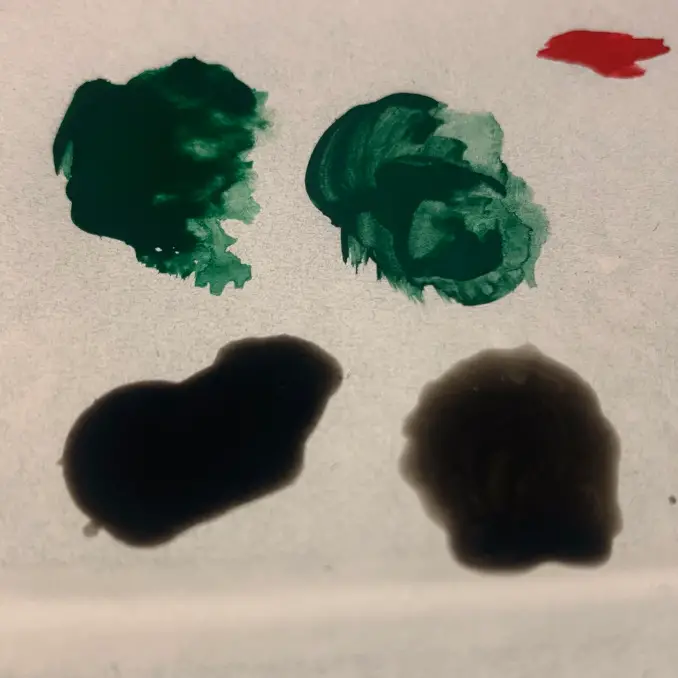
If you’re wanting to apply an all-over wash like I did above, ensure you thin the paint accordingly. Otherwise, you’ll need to make sure you drop the wash into the recesses you want darkened and keep it well away from any other textures.
Anyway, moving on.
Normally at this point, I’d hit each model with a heavy drybrush of Caliban green in order to start transitioning from the base and wash colour back to that original green. Following quite a heavy drybrush of Wyvern Green/Caliban Green, that dark green base was able to start peeking through again. However, the overall base colour of the Two Thin Coats miniature (below left) is noticeably darker than that done with Citadel paints (below right).
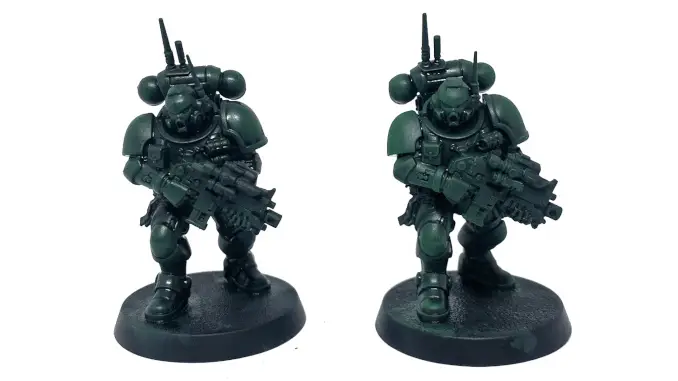
I actually went back and re-drybrushed more Wyvern Green on the Two Thin Coats miniature in order to create more uniformity between the two miniatures after I took the picture above. This did help, but compared to Citadel paints, Two Thin Coats paints aren’t as easy to drybrush.
Because the paints are that touch thinner than the Citadel paints, the Two Thin Coats paints require much more thought and control in order to drybrush them as they tend towards being slightly damper on the brush and, therefore, more prone to smearing. You’ll apply less paint with each stroke of a drybrush, and will, therefore, need to drybrush more.
Experienced painters will be able to get around this without issue, but novice painters might be caught out. It’s worth being aware of, and definitely something to experiment with.
So, whilst there are some minor differences in performance between Two Thin Coats paints and Citadel paints, that colour matching? Yeah, more or less spot on.

In the image above, I’ve applied all the base colours to both miniatures. There’s so little in it between shades that if the remnants of the super-heavy Oblivion Black wash wasn’t still peeking through the on the model on the left, there’d be no way of telling between the two.
Next, highlights.
Now, similar to Citadel’s Colour System – you know, the whole base, shade, highlight thing? – Two Thin Coats’ paints work in colour triads. Paints come in groups of three, with a Shadow, a Mid-tone, and a Highlight. This is designed to make adding depth of colour to your miniatures super easy.

And it works a dream – take a look at the green in the WIP image above. After a lighter drybrush of Emerald Green/Warpstone Glow, I could add an edge highlight of Ethereal Green/Moot Green. What’s more, the colour match was perfect.
In fact, the mid-tone and highlight colour matches between my usual Citadel colours and the Two Thin Coats alternatives were spot on in all but two cases. Usually, I’d do a Mephiston Red/Evil Sunz Scarlet/Wild Rider Red colour on the red areas of my Dark Angels. Unfortunately, Two Thin Coats’ range doesn’t include a Wild Rider Red alternative (yet). Instead, I used Sanguine Scarlet (which is a Mid-tone in the Two Thin Coats range), then Demon Red, and finally a Fanatic Orange highlight. Also, I’d usually do the black areas Abaddon Black/Eshin Grey/Dawnstone, but the Two Thin Coats range doesn’t have an Eshin Grey, so I used its Mechanicus Standard Grey alternative (called Dungeon Stone Grey) instead.
In my case, these differences are so minor that you’d have to really go looking for them to find the deviations, but for more experienced painters – or for people who are super committed to their colour scheme – this will be a turn off. This isn’t a shortcoming of the colour mixes, however – the paint simply doesn’t exist within the Two Thin Coats range yet. Given time, this will likely change.
With everything painted, here are the finished models:

No?
Well, here’s the figure painted entirely with Citadel paints (which is the one on the right).

And here’s the Two Thin Coats miniature, which is the one on the left:

Now, there is one big difference that you’ll notice now the minis are close up: the edge highlights. Because the Citadel Layer paints are much heavier than the Two Thin Coats Highlight paints, the edge highlight on the Citadel model is much more pigmented.
It’s easier to get a solid edge highlight with the Citadel paint, whereas if I wanted the same level of opacity with the Two Thin Coats paints, I’d need to edge highlight everything (you guessed it) twice. And I don’t want to do that, because that’d take forever…and I’m an extremely lazy painter edge highlighting is hard.
But (and this is quite a big but), by sacrificing thickness in their Highlight paints, the Two Thin Coats range makes itself a little more versatile. The thinner mix offered by the Two Thin Coats paints lends itself to blending, glazing and other more advanced techniques, which will appeal a great deal to experienced painters. It also allows for a more realistic build up of highlight straight out of the bottle (several of my colleagues and friends prefer the highlight on the Two Thin Coats miniature as it’s slightly more subtle), whereas a Citadel alternative would require more manual intervention from the painter.
In terms of how the paints performed on a wet palette, overall there was little to no difference between each range. After being left sealed on a wet palette (RedgrassGames Everlasting Wet Palette Painter 2) overnight, all the paints were good to go the next day, or were easy enough to reactivate with a touch of water.

I have very little negative to say about these paints. The thickness of the washes caught me off guard completely, but the entire Two Thin Coats range is built around that core Duncan Rhodes ethos: keep it simple, and always apply two thin coats to your miniature (unless they’re washes, apparently, then for god’s sake thin them down).
Even without being thinned with a little water, the Two Thin Coats paints are just that little bit thinner than many alternative acrylics. For advanced painters, this opens up whole worlds of possibility. For newbies, this saves your miniatures from being saturated in thick acrylic paint and all the detail being lost.
The implementation of the painting triad system (with Shadow, Mid-tone and Highlight paints) is an excellent idea. This makes understanding colour transition and highlighting so easy for brand-new painters, and also makes grabbing the right colour for your scheme extremely easy.
Below I’ve included a list of all the paints used to paint both of these Infiltrators. Of the 60 paints in the range, I managed to use a not-too-shabby 28 of them when painting one miniature.
| DRPA Two Thin Coats Paint | Citadel Paint | Role |
| Wyvern Green (Shadow) | Caliban Green (Base) | Armour basecoat/first drybrush |
| Emerald Green (Mid-tone) | Warpstone Glow (Layer) | Armour mid-tone/second drybrush |
| Ethereal Green (Highlight) | Moot Green (Layer) | Edge highlight |
| Sanguine Scarlet (Mid-tone) | Mephiston Red (Base) | Eyes, weapon casing and right shoulderpad freehand base colour |
| Demon Red (Highlight) | Evil Sunz Scarlet (Layer) | Eyes, weapon casing and right shoulderpad freehand mid-tone |
| Fanatic Orange (Highlight – not a match) | Wild Rider Red (Layer) | Eyes, weapon casing and right shoulderpad freehand fine highlight |
| Marine Blue (Shadow) | Macragge Blue (Base) | Weapon lens base colour |
| Elysium Blue (Mid-tone) | Calgar Blue (Layer) | Weapon lens mid-tone |
| Celestial Blue (Highlight) | Blue Horror (Layer) | Weapon lens highlight |
| Doom Death Black (Shadow) | Abaddon Black (Base) | Ribbed under armour base colour |
| Dungeon Stone Grey (Highlight – not a match) | Eshin Grey (Layer) | Ribbed under armour mid-tone |
| Wizard Grey (Shadow) | Dawnstone (Layer) | Ribbed under armour highlight |
| Cuirass Leather (Shadow) | Rhinox Hide (Base) | Pouches, holsters and belt base colour |
| Boar Hide (Mid-tone) | Doombull Brown (Layer) | Pouches, holsters and belt mid-tone |
| Fur Cloak (Highlight) | Tuskgor Fur (Layer) | Pouches, holsters and belt highlight |
| Dragon Fang (Shadow) | Zandri Dust (Base) | Purity seal parchment base colour |
| Skeleton Legion (Mid-tone) | Ushabti Bone (Layer) | Purity seal parchment mid-tone |
| Vampire Fang (Highlight) | Screaming Skull (Layer) | Purity seal parchment highlight |
| Sword Hilt Burgundy (Mid-tone) | Screamer Pink (Base) | Purity seal wax base colour |
| Glistening Gums (Highlight) | Pink Horror (Layer) | Purity seal wax highlight |
| Sir Coates Silver (Shadow) | Leadbelcher (Base) | All silver metallic areas base colour |
| Plate Armour (Mid-tone) | Ironbreaker (Layer) | All silver metallic areas mid-tone |
| Mythril Blade (Highlight) | Stormhost Silver (Layer) | All silver metallic areas highlight and spot highlight on pouch buttons |
| Spartan Bronze (Mid-tone) | Balthazar Gold (Base) | Shell casings in weapon magazines |
| Dragon’s Gold (Mid-tone) | Retributor Armour (Base) | Skull and crossbones marking on chest |
| Oblivion Black Wash (Wash) | Nuln Oil (Shade) | All-over wash for green armour and silver metallic areas |
| Battle Mud Wash (Wash) | Agrax Earthshade (Shade) | Wash for brown areas |
| Berserker Red (Shadow – thinned with water) | Carroburg Crimson (Shade) | Wash for red areas |
| White Star (Highlight) | White Scar (Layer) | Spot highlight for eye and weapon lenses |
Duncan Rhodes Two Thin Coats Paints Review – Price and Availability
You can grab each Two Thin Coats paint for £3.75 from Element Games. To keep a consistent point of comparison, straight from GW a like-for-like paint would cost you £3.70, so there’s not much in it. That Two Thin Coats paints come in a dropper bottle with agitator will appeal very strongly to some people.
However, the Two Thin Coats paints won’t be as easy to get your hands on as Citadel paints simply because they’re a new range and are non-GW. Check in with your FLGS (or, you know, just click on one of our affiliate links and buy ’em from Element Games – we gotta eat too!).
Duncan Rhodes Two Thin Coats Paints Review – Final Thoughts
| Pros | Cons |
| Near-flawless colour matches, but not “copycats” of other paints as different consistencies and behaviours Very easy to implement into a current existing painting recipe Enforces good habits Versatile range Dropper bottles have agitators, which is always a nice touch | Dropper bottles are a bit leaky Not a massive range (yet!) Surprisingly heavy washes |
As reviewers, it’s more or less impossible for us to recommend one paint range over another. Paints, like so many over aspects of the hobby, are viciously personal. Everyone paints differently, and the subtle differences between each paint range will only become more obvious the more experienced you get as a painter.
Some people prefer heavy Citadel Base-like paints that can be sloughed on in only a few coats. Others prefer thin, glaze-like paints that need to be applied in 100 layers. Two Thin Coats paints straddle this gap, committing to neither the ultra-heavy nor the extremely-light makeups you may find in other paints.
Whilst they bear similarities to other ranges – such as we’ve seen above in the comparison to Citadel – Two Thin Coats paints are still very different. They will appeal to both beginners and more experienced painters due to their slightly thinner mixes that do not sacrifice pigmentation strength. They require a little bit more work due to their slightly thinner recipe, but this isn’t necessarily a bad thing.
That they come in dropper bottles with agitators will have certain painters who aren’t fond of certain alternative potted paint varieties cheering, but that they are a touch more expensive than a lot of alternatives may also put people off. As we also saw at the top of this review, the bottles are also prone to a bit of, shall we say, discharge, which can lead to wasted paint.
But the overall performance of these paints is excellent. The amount of work, experience, and passion that has gone into each of these dropper bottles is plain to see in each stroke of paint. There’s a huge amount here to be excited about, and the range is only going to grow as Duncan and Trans Atlantis Games enjoy more and more successes.
We would strongly recommend you give Two Thin Coats paints a go – grab one of the colour triads and try switching it with your usual recipe for a particular colour. See what you think.
We’ll be very surprised if you’re disappointed.
Also, Trans Atlantis Games’ brand-new Kickstarter for Two Thin Coats Wave 2 has just gone live! Head over to the link to get your pledges in early!
Please Note: This site uses affiliate links. Our Affiliate Partners are shown below
(Affiliate links will result in compensation to the site on qualifying purchases)
Click this link & buy your hobby stuff from Element Games for the UK & Europe to support FauxHammer.com – Use Code “FAUX2768” at the checkout for double reward points.




Our Affiliates / Hobby Stores
- UK: Element Games, The Outpost, Wayland Games, Mighty Lancer, Goblin Gaming, Forbidden Planet, Model Scenery Supplies, eBay, Amazon
- US/Canada: MTechCave, GameKastle, eBay (US), eBay (CA), Amazon
- Germany: Taschengelddieb
- Europe: eBay (DE), eBay (FR), eBay (ES), eBay (IT), Amazon
- Australia: eBay, Amazon
- Global: RedGrass Games, Warcolours
- 3D Printers: Phrozen 3D, Elegoo, Anycubic
FauxHammer – Latest Video on YouTube
What did you think of this Review? please let us know in the comments.
If you like what we’re doing here you could really help encourage more content with a share on any social media platform.
Click the share links at the bottom of this screen (or on the left for computers and tablets)
Want to keep updated with the site? You can subscribe in the sidebar for RSS or by email below
(Sidebar is below the article on Mobile Devices)







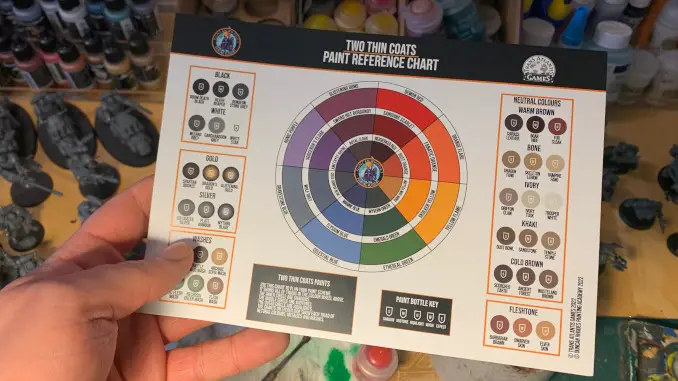


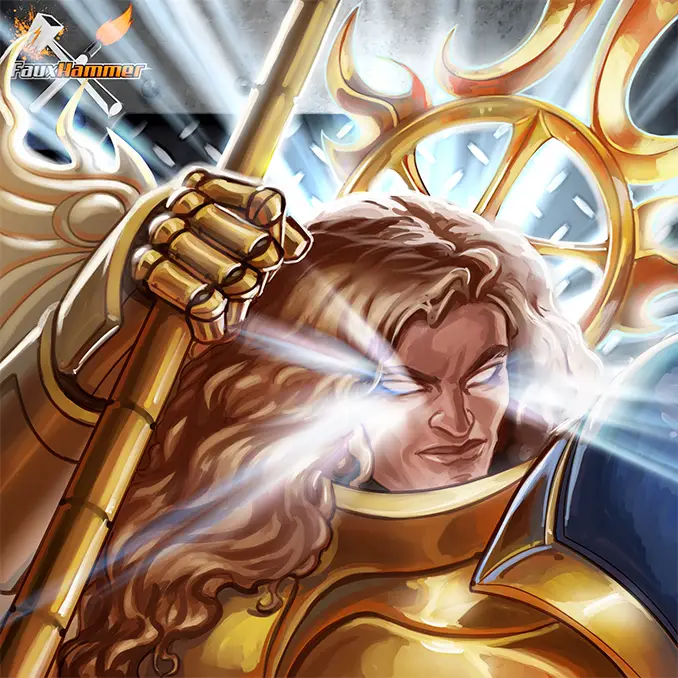
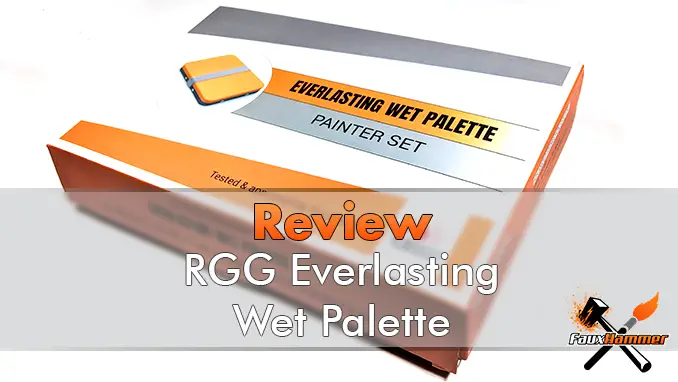


Great review! Regarding the shades, I confirm what you said: in his video, Duncan quite oftern dilute them 1:1 with Lahmian medium, so this is something everyone might consider before “ruining” their minis.